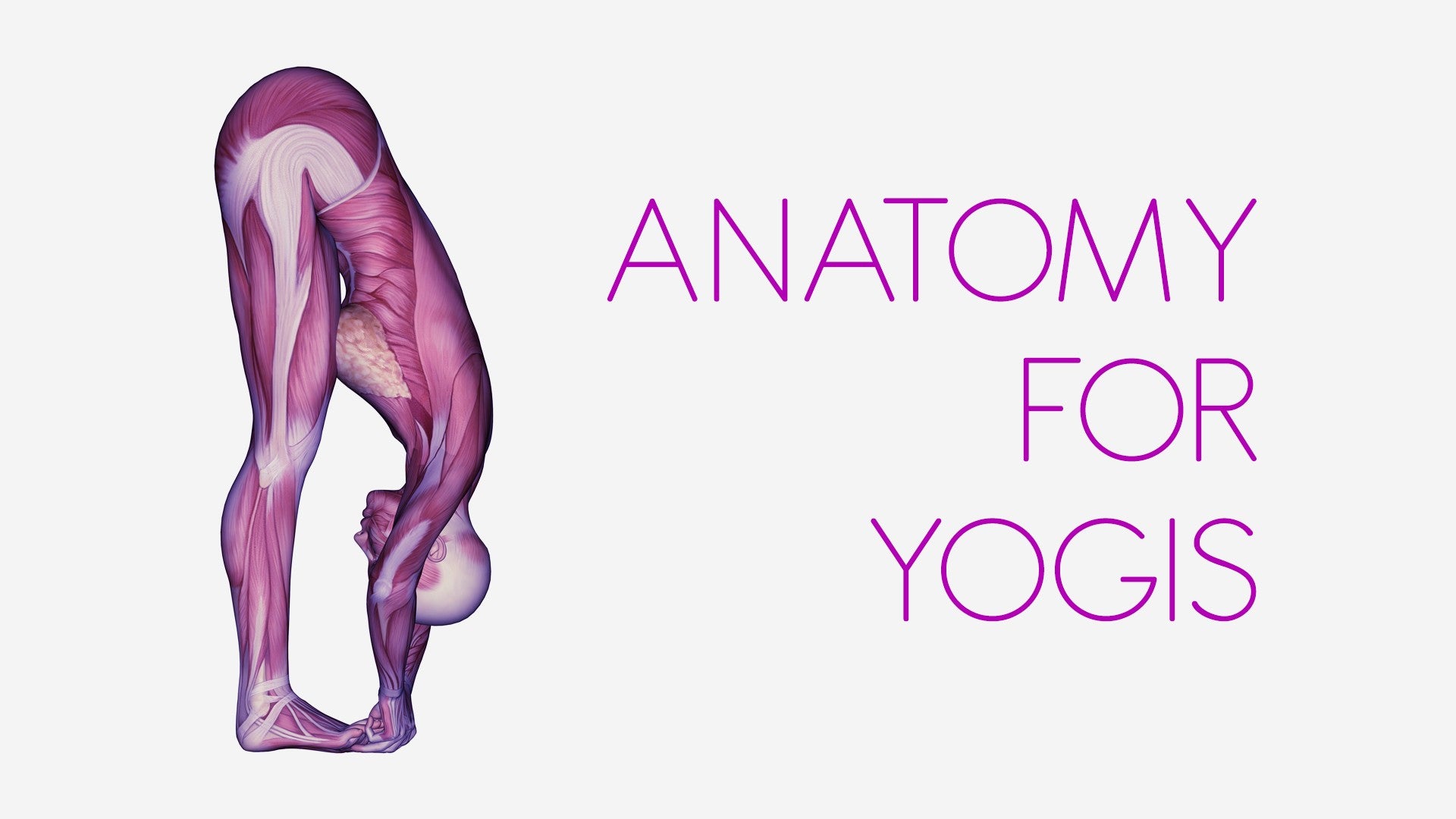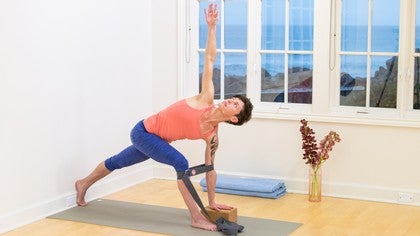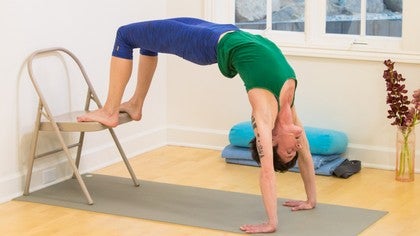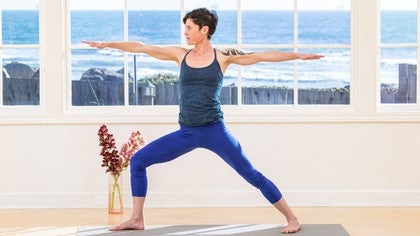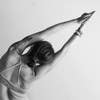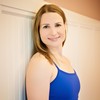Description
About This Video
Transcript
Read Full Transcript
Hey, everyone. Thanks for joining me today. We'll be doing a standing series. And this standing series is sequenced for people who are a little bit looser in their joints. Typically, in the standing series, when you get into the postures, you do more kind of opening and external rotation in the hip joints to begin with. For people in tighter bodies, this is generally going to make them happier than doing twists first. However, for those of us who are a little bit looser in our joints, especially if we're dealing with any SI or hip instability, starting with more containment and twisting and working tighter in towards midline before opening up, just gives more support and kind of a sense of grounding when we get to those wider and more externally rotated postures. So this is a longer standing series and we'll end in Tadasana. For those of you that would like to take this into another practice, the back bending practice would be really nice way to follow this one up or the restorative practice as well. But otherwise, you can end in Tadasana and then take it into your day. So we're going to start off lying on our backs. And you'll want to have a block and maybe block blanket combo close by as well as a strap. I'm going to be using a wall for a lot of this series. So if you can position your mat near a wall, that would be great. All right. So we'll start off today in what's called constructive rest. And constructive rest is lying on your back with knees bent, feet about the distance apart of your outer hips. And here you don't want to let your knees rest in towards one another, but feel that your knees are aligned to your hips. And let's just let the hands rest at the front of the pelvis and you can close your eyes. So we'll start here just more with our meditative awareness, letting anything that's in the past be in the past. No need to think about it. Anything that hasn't yet happened, be in the unknown. And bring your attention to your breath. There's nothing to do with your breath other than just notice. So here on our backs, I'll invite you to bring your awareness into your back body. And feel the places in your body that are connecting to the floor, the soles of your feet, the back of your pelvis, your middle and upper back, the back of your head, your shoulders, and the weight of your upper arms and elbows. And in the places where your body is, connecting to the floor is getting a sense of yield. So in yielding, we come into an active relationship. There's a readiness to respond, but not necessarily a state of being in response yet. You might think about letting your skin wake up here. Maybe just feeling the texture of your sticky mat underneath your feet or your mat or your blanket under your body. There's a lot of choice that we have in relationship. And for those of us that are dealing with hypermobility, it's really important to remember and to feel that sometimes the amount of choice that we have is the problem. So if you have joints that can move in a lot of different directions, it's not always ideal. And what we look for and how we can find support is through resistance. So I'd like you to start to just experiment with really gently pushing through the soles of your feet. And notice how the push through your feet sequences through your body. And it might sequence into your pelvis, maybe into your back or into your head. And then if you push into your elbows or into your upper arms, notice how that push kind of sequences essentially in towards your spine. So try just pushing really gently through wherever you feel the floor in relationship to your body. And notice how pushing leads to movement. And it's a subtle movement right now. But pushing and meeting resistance leads to movement through the body. But it's a type of movement that is it knows its own strength. So as you push, it brings sensation through your body. It brings awareness and movement that travel through your flesh. And this type of pushing or this type of action in your body is strengthening and supportive. And it's a little bit of a different sensation than say, reaching. So just to notice what that difference is, you could reach through, let's say through the top of your head. And feel the difference in sensation if you reach through the top of your head than if you push the back of your head against the floor. And for me, I feel a very kind of market difference in my abdominal wall when I push or when I reach. And the push sensation tends to give me more muscular engagement. Whereas the reach sensation in effect would take me out of my own kinesphere. And so in order to reach and to reach in any way that's integrated or supported, we actually need push underneath it. It makes me think of the quote that I believe is attributed to Krishnamurti, which is that we know ourselves by knowing ourselves in relationship. When we feel that we can push into something, that there's contact, then we get a sense of what our own potential is.
So let all of that go for the next few breaths. And simply take these breaths to arrive here right now. Greeting your body. All right. So we'll set up for our first pose here. And that pose is supta padangastasana, or hand to foot pose, reclining at the wall. And I like a block with a blanket for cushion right next to your left hip. And then you want to be a distance from the wall so that when you extend your legs, it almost feels like you're standing on the wall. Get your belt. Right. So we'll start by taking the left knee in towards the chest. And let's just take a few breaths here with hands interlaced around the left shin. So as you breathe, feel that kind of your inner body, the weight of your organs can rest towards your back, rest into your back body. So you're not thrusting your lower belly forwards. And as you feel your lower back widen, from the space to the right of your belly button, reach down through your right leg and press into the right foot. And we're keeping the right leg really active. And again, just as if you're standing on the wall. And then from here, you can bring your belt loop, or just your belt, and bring it around the sole of your left foot. And you can bring it actually closer to your heel than to your toe. And then extend your leg up towards the ceiling. All right. So a couple of things first. For those of you with the tendency to hyperextend through the back of your left knee, what I'd like you to think about is the inner and the outer knee lengthening towards your foot as the back of your left thigh or your hamstring actually lengthens and moves towards your sit bone. And I know that sounds complicated, but I think you'll be able to feel it. So from the inner and the outer knee, you want to reach towards your foot. And then kind of firming your hamstring in towards the bone. Imagine that your hamstring is going to slide towards your sit bone. And we want to get kind of an even reach between the inner and the outer knee, and then an engagement through the lower hamstring. Okay. So let's take just two more breaths here and go back to the first cues, which are to let your organs rest to your back body, and from the right side of your navel to reach into your right leg. And then from here, we'll begin to externally rotate the left leg and go ahead and turn your left toes towards the left and your block is set up next to you. So it's going to catch your upper outer thigh bone as you bring your leg out to the side. So you're not going into the deepest pose you've ever been into. You might feel some gentle opening through the inner thigh, but here, what we're doing is we're using the prop to actually keep the thigh bone seated in the hip joint. And I'd like you to imagine that you're standing again through both legs. And on the right leg side, you're still reaching from the right side of your belly button into your right foot. And on the left leg side, you can just imagine this left leg softly settling into the left hip joint. Right. And then please return your leg back to the center. And then we'll switch the grip so you can hold your strap with your left hand and without hiking your left hip up and without rolling onto the right side of your pelvis, just start to cross your leg over your midline. And for me, I only need to go a few inches before I feel that my left IT band is saying hello. And from here, I want to continue to engage through my knee so that the inner and the outer knee reach towards my foot and the hamstring, it gets a sense of kind of resting back on the bone and then sliding towards my sit bone. The right leg is still active. That one for me is always one I need to do. All right, so I'll come back to the center and then prepare to switch sides. So you can move all of your props now over to your right. And again, position your block so that it's just next to your upper outer thigh bone. Extend your left leg forward so your left heel presses against the wall.
And then go ahead and bring your right leg in towards your belly and interlace your hands around your shin. So in this first couple of breaths, we're practicing kind of easeful width through the back body, your organs resting back. And we're practicing engagement of the standing leg. And you can, again, think of your leg kind of starting up around your belly button height and from the left side of your navel reaching down into your foot. And then grab your strap and bring it around the sole of your right foot. So when you bring your strap closer to your heel than to your toe, you get a different type of kind of neuromuscular engagement here that allows kind of a clear line through the bones of the legs, which your weight bearing through your leg goes through your shin and right into your ankle, which is just about where the strap is right here. And we want to feel that the ankle back into the hip joint then have a clear relationship as well. So you're reaching from the inner and the outer knee, lengthening, opening the back of the knee joint towards the foot, and then feeling that your right hamstring can gently firm in towards the thigh bone and slide towards your sitz bone. And let all of your kind of the weight of your body rest into your back, even though you're activating this leg. And then from here, start to turn your right toes to the right and you can hold your strap pretty close to your foot and guide your right leg down so that the prop catches your upper outer thigh bone. And in this pose right here, we're preparing for a pose we'll do later in the series called Half Moon Pose. And so what I want you to feel is how the prop actually delivers your upper outer thigh bone forwards or towards your front body. And what is the back of your hip joint, so more towards your bum, is collected in towards your pelvis. So the weight of your leg isn't falling towards the earth here, but it's gathering in towards the heavenly side of your body right now. And then continue to reach through your left leg. And then on an inhale, you can bring your right leg back to the center. And again, switch your grip, holding your strap with your left hand. And without hiking your right hip up, start to guide your right foot over towards the left. So I'm actively reaching from the left side of my spine into my left foot. And on the right side, I feel that my back body is getting wider and spreading from my spine to my outer hip. And then I'm reaching from the middle of my hip joint into my ankle. And inhale back to the center. So we'll release the strap and you can just move your props over to the side. All right, so go ahead and hug both of your knees in towards your chest. And take an inhale. With your exhale, using your hands around your knees, curl your forehead up towards your shins. And then as you inhale, release your head back. Let's do that two more times. Next exhale, curl in. And inhale to the floor. Again, exhale. And then inhale. That would be one place to stay. If you want to continue from here, second variation would be to take your feet up towards the ceiling and your arms back alongside your ears. So then we'll inhale here. And then with your exhale, come into the little embryo shape. You can circle your arms out, hug your shins and curl your face in. And then we'll inhale, legs up, arms back. And exhale, curling in. And once more, inhale. And exhale. And then inhale onto your back. So you can continue with either of those two variations if you want to give a little bit more effort and strength building to your abdominal wall. Start to take your legs forwards at an angle. So here we'll inhale. And then exhale and curl in. And inhale. And exhale. One more time, inhale. And exhale. And then inhale, come onto your back. Bring your arms out to the sides. So with your knees bent, use your belly strength here to roll your thighs a little bit more towards your chest. And then roll to your left so that the knees come maybe about six inches from the floor. Keep reaching through your right arm. And then inhale back to the center. And exhale, legs to your right. And then inhale back to the center. So that's variation one. That's option number one. Option number two will be with legs straight. It's a fair amount harder with legs straight. So feel free to go back to option one at any time. For both options, though, when you take the legs over to the side, you want to be careful that your legs are actually, excuse me, your hip joints are actually bent more than 90 degrees. So you're in just a little bit of spinal flexion. Not doing a back bend here. We want to kind of protect the integrity of the SI joints in the lower back. So for option number two, I'm going to use the strength of my belly to bring my legs a bit closer to my torso. And then roll so that my legs come about six inches from the floor. And then keeping my legs close in, come back to the center and then over to the other side. So whatever option you're doing, let's take two more. Inhale as we go over to one side. And then exhale to the center. Reaching through both arms and inhale to the other side. And exhale to the center. Last time coming to the first side. And back to center. And second side. And back to center. And then hug your knees in. So just for the camera right here, I'm going to have to turn around. All right.
So we're going to start rolling a little bit on our backs. And I should have said before that I like to have a blanket just to cushion my spine against the floor. You can start by holding your shins with your hands and bringing your forehead up. And then using the momentum of your legs rock back and start to rock up. When you're rocking, if it's possible to come to balance without touching your feet down, great. Try not to let your head come to the floor. From here, you want to go forwards. You can keep your knees bent and let your arms come and almost like you're holding a beach ball. Right? So here's option one. Or one A with the arms out. If you want to continue from here, we'll start to move towards coming into a squat. You want to bring your feet to the floor. Reach with your arms to come forwards. Starting to get some momentum. You want to go further from here. You can stand up. Reach with your arms up. Turn the corners of your mouth up. It helps. And then maybe give yourself a little hop. Really push your feet down. Again, that pushing strength through your body. Let's do one more. And come all the way up. And release your arms down. All right. So I'm just going to readjust my props. Have your mat ready to step back for some standing poses. So we'll meet back at the top of the mat. And let's find a tadasana with your heels kind of sit bones distance with the part. And come back into Urdhva Hastasana with the arms up. Take an inhale. And then as you exhale, turn your palms to the side and release your arms down. Do that four more times. Inhale. And then exhale. Inhale your arms forwards and up. And exhale your palms out and down. Once more. And then come in one more time and this time hold with your arms up. So we'll be here for a number of breaths. And what I'd like you to do is bring your attention to the pelvic center or the place between pubic bone and navel but a couple of inches in away from the front of your body. So towards your spine. And from that place, imagine that you can reach up into your arms. It's almost like a bird. Like their bird's wings start down at their tail. You think about right from the middle center of your pelvis is the anchor and the root for your arms. And feel that there is an even amount of awareness between your front body and your back body. And any effort that's gathering around your shoulders or your neck, let it soften and melt. Stay for another five breaths. In the center of your pelvis you can reach simultaneously into your legs. And here we're taking a couple of breaths to feel that the limbs connect in right into the center of the body. And then turn your palms to the sides and take a slow count of five to lower your arms down alongside you. Reach through the fingers for four, three, two, and one. And then as your arms come down beside you relax their effort and just allow your eyes to close and notice what sensation is there. Notice the length of your spine. I'd like you to keep your awareness in your pelvic center. So again, just about halfway between your pubic bone and navel. And then from that space go about two inches to your left. And we could think about this being the top of the left leg. And I'd like you to transfer your weight into your left foot. But without swinging your left hip to the side. So you're reaching right through the center of your left thigh bone from this place. Just a couple of inches to the left of your navel. And then you can bring your right knee forward. And let's take the arms forward and up again.
We'll just move with breath a couple of times. On the exhale reach your right leg back as your arms come forwards. And then inhale and come back to the first shape. So exhale, come back. And then inhale. Come up. Again, exhale. And inhale. Let's do two more. Exhale. And inhale. And then this time you'll hold. So take your right leg back. Reach forwards through your arms. And again see if you can find that place. Just a couple of inches to the left of your belly button and reach down through your left leg. And find the corresponding place on the right side and reach back through the right foot. And then start to bend your front knee. We're gonna take the right foot all the way back for a twist. Excuse me, not a twist. A lunge. That's what this shape is. Keep your arms up. Take an inhale breath here. As you exhale, bend your back knee, your right knee, and hover it just above the floor. And then inhale and straighten your right leg. We'll do this four more times. We're bending the knee. A lot of containment in the pelvic center. And then as you straighten it, similar to the first shape, reach through the inner and outer knee. Bend. And straight. Two more. Bend. Straight. Last time. Bend. And straighten. And then go ahead and reach forwards once again. And almost like someone's pulling your right knee forwards. Come back to stand. And then set both feet down. And both hands down. Okay? So once again, kind of just locating this place in the pelvic center. And it's in this place that we want to feel the outer hips hug in. Catch my breath. Transfer weight onto the right side. So again, I don't want to pop my right hip out to the right. But I'm reaching right through the midline of my right leg. Bring the left knee forwards in that. Inhale. And exhale. Inhale. Exhale. And last one. We'll inhale here. And then exhale to come back and hold. From the pelvic center I want to reach through both legs. And then starting to bend the standing knee and reaching the left foot back for a long lunge. Arms can come up. And then I'll exhale and hover the back knee down. As I straighten the leg, really reaching through the inner and the outer knee. So moving through three more times. So inhale and bend. And exhale. And inhale. Exhale. Last one. Inhale. And exhale. And then I'll reach my hands forwards and pull the left knee forwards and up. And then step both feet down. Bring both arms down. All right. So I'm going to transition to use the wall now for a lunging twist. And you'll want your block and strap. To catch my breath after doing that. It's hard to move and talk at the same time. All right. So make a loop with your belt. And you'll want it as wide as your outer hips. And then you can bring your belt loop around your left shin.
And we'll set up for this lunge with the back foot against the wall. And then lock on the lower level. All right. So my positioning here is that the belt loop is below my left knee but above my right elbow. And I want to use my props here actually to give me resistance or push so that I feel my own core strength. So I'll start by pushing down through the front of my left heel. And back through the front of my right heel. And then from the pelvic center, so that space kind of between my navel and pubic bone, I'm kind of imagining that that's where my legs are grouping into. Okay. From that space, I want to find containment button from just behind my belly button. That's where I want to twist. So one thing that a lot of us with really wobbly hips or a lot of choices in our hips might do in a twist is let this back hip drop quite a bit. Rather than doing that, I'm going to really try and find stability through both of my legs. And then from the back of my belly button, start to twist so that it's my ribs that rotate. And then from here, I can take the left arm up. Okay. The strap is there to give me something to resist. Give me something to push out against. I'm going to fill the space between the front and the back of my chest. And similar to the first shape, it's almost like I want to let my organs rest into my back body. From my back body, spread through both arms. And then I'll exhale and release down. And then from here, I'm just going to switch sides. You can step your back foot in. So I love using props. I think that they can be such great teachers. So again, the strap is below my right knee, above the left elbow. The space that's about halfway between pubic bone and navel is kind of around the top of your sacrum. So if you want to bring your hand onto the back of your pelvis and just feel that space. And from that space, push through both heels and also feel your legs collect in. And then from just behind your belly button, starting to twist. And so the back body stays really broad. Trying not to do any back bending shape here. Right arm can lift up. And my left hand is using the block, but there's not a ton of weight coming through that hand. Mostly it's the strength of my legs holding me. And then with the exhale, go ahead and release your right hand down. Release yourself from your bondage. Step your left foot forward. Alright, now before we go into another pose, we'll just take a symmetrical shape. And this is similar to downward facing dog, but we'll be at the wall. So right angle or art at the wall. Even though I can go at 90 degrees here, because of my shoulders and because they're so limber, I'm actually going to have my hands higher than shoulder width. And what I'm practicing here is really coming into the strength of my chest muscles. So it's as if my upper lungs are floating towards the ceiling. And the trick is to maintain this and then allow my pelvis to release. So I'll show that again. One tendency is to kind of tuck the tailbone and either come into a rounded spine or like kind of flat back here. But in downward facing dog, we actually want to allow the sacrum to release. And the trick for those of us with limber shoulders is to keep strength through the front of the chest and through the biceps. So the inner arms as you release the sacrum back. And so this is practice for downward facing dog right now. I'm actively pushing the wall away. And I almost feel as if I'm drawing my arms towards one another. So my inner arms or the bicep sides are working. And then I'm practicing letting my tail release back without dropping my ribs towards the floor. Challenging pose. And then we can inhale and lift the gaze and come forwards and up. So the next standing pose we'll do is warrior two with the front leg against a block at the wall. So you'll want to place your block again below your knee. So you're wedging the block between your shin and the wall. And then here I'll practice with heel to heel alignment. And for those of us with a lot of movement capability, we're going to want to stay just a bit above 90 degrees. And then here I want to feel that on my back hip I'm not trying to square my hips to the long edge of the mat. I'm actually letting my pelvis turn a touch towards the wall. Because I want to be able to reach right through the center of my right hip joint. And then similar to the first pose, I want to open the back of the knee joint evenly. So I'm reaching from the inner and the outer knee towards my heel. And I'm firming the back hamstring almost and drawing it in towards my butt. And then from here the hands can just rest at the wall and out to the sides. And with this variation you can really feel how there's an opening at the waist and chest to the side. On the front leg side I'm actively pressing down the front of my heel and slightly forwards through my shin just to feel the strength in my front thigh. Okay. And then we'll come up for the second side so you can grab your block. Don't let it fall on your foot. Again heel to heel alignment. So you can see if I endeavor to try and square my hips to the long edge of the mat, it ends up doing something really funky in this front hip and front knee. So I'm letting my pelvis rotate so that I can reach right through, again this is a few inches to the left of my belly button as if my leg was starting up here. And reaching down right through the center of my knee joint, inner and outer knees lengthening towards the foot, hamstring firming and drawing towards the pelvis. From my waist I'm opening to the sides, opening the arms up, pausing and breathing. And then when you do this pose another time without the wall, the trick is to remember the feeling of the block and the feeling of the resistant push into the front leg. And grab your block and then go ahead and set it down. We'll use that again. So between the asymmetrical poses I like to practice symmetry. Again, for those of us with wonky SI joints or loose hips, it's really important to keep coming back to center. We'll go through a slower variation of Surya Namaskara. And I would like to show you how I jump back.
Jumping is fun, but if you have looser shoulders and any tendency towards hypermobility in the shoulders, it can be scary for the shoulder joints and sometimes damaging for them. So I'll show you how I like to jump back. We'll start in Tadasana. Take a full exhale out. On your inhale, sweep your arms out and up. With your exhale forward fold. Inhale into Arda Uttanasana. So you're setting your gaze forwards and you'll keep your gaze forwards. Now when you jump back, you'll come back and land with your knees bent in a crouch like so. So when I jump back like that, you can see I'm just going to take my knees to the floor. You can see that I'm not weight loading a lot in my shoulders. And then what I have in this pose is the strength of my legs to push me forwards. So again, push patterns in the body are strengthening patterns. And they let us know our own strength, our own capability. So from here, I can then take the strength of my legs forwards into plank. The first way through, let's go for knees down, Chaturanga. If you watched the arms video here, I'm using my finger pads as I come down. And then I'll come forwards and through for upward facing dog. And then exhale and come back for down dog. Now when I jump, I want the same kind of crouching feeling and the same gaze forwards. And I want to jump right at the end of an exhale. So here I'll prepare by inhaling and look up halfway and exhale and inhale to come all the way up to stand and exhale back to Samasthiti. Let's try it again, just with our movement and breath. Inhale, Uddhva Hastasana. Exhale, Hastasana. Inhale to prepare. Exhale. Inhale, plank. Exhale, low. And inhale, exhale. Take a full breath in. Exhale. And then preparing to come forwards. And we'll go one more time
Anatomy for Yogis: Renee Sills
Comments
You need to be a subscriber to post a comment.
Please Log In or Create an Account to start your free trial.
